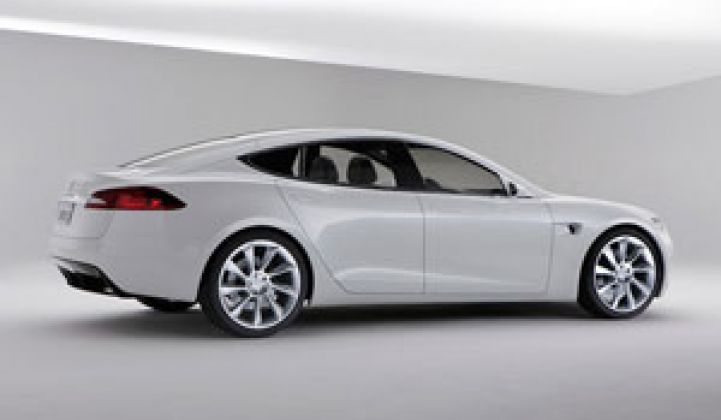HAWTHORNE, Calif. -- Tesla Motors will likely start delivering its Model S to customers in the fourth quarter of 2011, about a year after its original launch plan. But the delay might work in the startup carmaker's favor, considering that it wants to woo the masses with its all-electric ride.
The economy is in bad shape, and so are major carmakers from around the world. Car sales have plummeted. Consumers aren't likely to reclaim their appetite for new cars soon, and certainly not an electric car that isn't quite as affordable as a minivan.
Tesla has roughly two years to line up some key ingredients to make sure its third business – the sale of the Model S – will succeed, particularly when many major carmakers will soon launch plug-in hybrid-electric or all-electric vehicles. Tesla executives unveiled the Model S to much fanfare Thursday and trumpeted features that they hope will appeal to, among others, soccer moms. The lack of secured financing to build an assembly plant for the Model S remains a big problem. Its CEO Elon Musk appears confident about getting the $350 million in federal loan for the factory (see Tesla Will Build Model S in SoCal).
Tesla is generating revenues by selling its sporty, $100,000-plus Roadster, as well as designing and making powertrains. The company's CEO Elon Musk said back in October that the powertrain business already was profitable. Aside from building the powertrains for its Roadster, however, the only announced outside customer today is Daimler, which plans to use Tesla's battery pack, charger and software for its first 1,000 Smart EVs.
The company, founded in 2003, expects its Roadster business to become profitable by the third quarter of this year, said Diarmuid O'Connell, vice president of business development at Tesla, during an interview at the Model S unveiling.
The showing off the Model S – a prototype – kickstarted the marketing campaign for a four-door sedan designed to look edgy but filled with amenities that would attract not just the very rich. Musk and chief designer Franz von Holzhausen touted the roomy interior and the slick center console that comes with a 17-inch touch screen for Web browsing.
The hatch back design allows for five adults to sit in the front and rear passenger seats and more room in the rear cargo space for two child seats. Because the motor, power electronics, battery pack and other powertrain components are located across the bottom of the car, there is cargo space in the front, where an engine in today's passenger car would occupy.
"I thought to myself there was no way we could make a sedan that can hold a whole set of people, luggage, and is beautiful. One thing that the electric car's powertrain allows you to do, from an architectural perspective, is to create something like this," von Holzhausen said. "If a consumer sees this car that looks big and heavy, then they think it'll compromise the range."
Drive range is a sticky issue for consumers. Even though people don't typically drive more than 30 to 40 miles a day, they do take long trips once in a while and would prefer not to have to stop for hours to charge up their cars.
The Model S would take three to four hours to charge by using a 240-volt outlet. Using a fast-charging technology, the car's battery could be filled up in 45 minutes, Musk said. Tesla also designed the battery to be easily removed under 5 minutes, in case the idea of battery swapping idea championed by Better Place becomes widely adopted, said Tesla's CTO J.B. Straubel, during an interview.
At a starting price of $57,400 ($49,900 if you include the federal tax credit), a standard Model S would come with a battery pack that allows for 160 miles per charge. Consumers can upgrade to battery packs that would prolong the range to 230 miles and 300 miles (Tesla hasn't announced the prices for the upgrades). Musk said it'd cost about $5 to charge up a 230-mile model. So giving the fuel savings, the cost of owning the car would be comparable to the cost of owning a $35,000 gasoline-powered sedan such as Ford Taurus, he said.
Better chemistry and engineering have made it possible for Tesla to improve the batteries while lowering the drag co-efficient, Musk said. The company buys battery cells from mostly Japanese makers and integrates them with a cooling system and electronics to manage the charging.
The battery pack for the 230-mile or 300-mile range is made up of 8,000 cells, compared with the 6,800 cells in the battery for Tesla's Roadster, a $100,000-plus sports car with a 244-mile range. Tesla is using better cells for the 300-mile battery pack, hence the number of the cells is the same as the battery for the 230-mile range, Straubel said. The battery pack for the 160-mile range comes with 5,500 cells.
"We took what we'd learned with Roadster and focused on building [Model S] with less labor and higher volume," Straubel said.
The Model S can go from zero to 60 miles per hour in under six seconds, and it tops out at 130 miles per hour. The company plans to make a sporty version of the Model S, likely in 2012, that would have all-wheel drive and can zoom to 60 miles per hour in under five second, Musk said.
Tesla plans to start producing the Model S in the third quarter of 2011, Musk said. O'Connell said delivery is likely to start in the fourth quarter of that year. The first 2,000 Model S cars (1,000 in the United States and 1,000 in Europe) will be called the "signature edition" and come with the battery pack for the 300-mile range. Customers will have to plunk down $40,000 to reserve one of these, said Aaron Platshon, Tesla's marketing manager.



